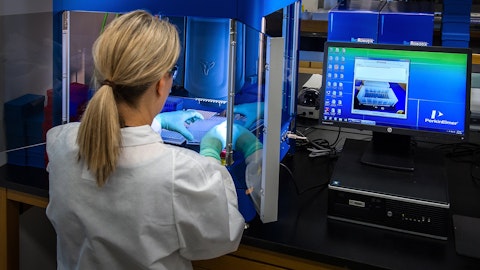Verona Pharma plc (NASDAQ:VRNA) Q2 2023 Earnings Call Transcript August 5, 2023
Operator: Welcome to Verona Pharma Second Quarter 2023 Financial Results and Operating Highlights Conference Call. At this time all participants are in listen-only mode. Earlier this morning, Verona Pharma issued a press release announcing its financial results for the 3-months ended on June 30th, 2023. A copy can be found in the Investor Relations tab on the corporate website, www.veronapharma.com. Before we begin, I’d like to remind you that during today’s call, statements about the company’s future expectations, plans and prospects are forward-looking statements. These forward-looking statements are based on the management’s current expectations. These statements are neither promise, be guaranteed and involves known and unknown risks, uncertainties and other important factors that may cause the actual results, performance and achievements to be materially different from the expectations expressed in implanting for forward-looking statements.
Any such forward-looking statements represented management existing on the date of this conference call. While the company may elect to update such forward-looking statements at some point in the future, it declaims any obligation to do so, even if subsequent events cause its views to change. As a reminder, this call is being recorded and will remain available for 90 days. I would now like to turn the conference over to Dr. David Zaccardelli, Chief Executive Officer.
David Zaccardelli: Thank you, and welcome, everyone, to today’s call. With me today are Mark Hahn, our Chief Financial Officer; Dr. Kathy Rickard, our Chief Medical Officer; and Chris Martin, our Senior Vice President of Commercial. During the second quarter, we made substantial progress towards our goal of bringing ensifentrine to COPD patients with the submission of a new drug application to the FDA for nebulized ensifentrine for the maintenance treatment of COPD. The NDA submission is comprised of data from the successful Phase 3 ENHANCE program and other ensifentrine clinical studies, including safety data from approximately 3,000 subjects. We look forward to working with the FDA on the submission and providing an update in the third quarter.
In May, we presented additional analyses from the ENHANCE studies at the American Thoracic Society International Conference across 12 abstracts and a clinical trial symposium on subgroup data and pooled analyses from ENHANCE 1 and ENHANCE 2 covering exacerbations, symptoms, quality of life, use of rescue medication, health care utilization and safety. In addition, an overview of the ENHANCE trial results was presented as part of the clinical trial symposium reserved for highlighting new breakthrough drugs. In June, the results of the ENHANCE trials evaluating ensifentrine in COPD were published in the peer-reviewed publication, American Journal of Respiratory and Critical Care Medicine. In parallel with our regulatory progress, we continue to advance our pre-commercial medical affairs and marketing activities as we prepare for the potential U.S. launch of ensifentrine in the second half of 2024, pending FDA approval.
These efforts are critical in setting the stage for ensifentrine, which if approved, has the potential to be the first novel mechanism of action launched for the maintenance treatment of COPD in over 10-years. Turning to our global partnering strategy. In the second quarter, Nuance Pharma, our development partner in Greater China announced they enrolled the first subject in their Phase 3 trial evaluating ensifentrine for the maintenance treatment of COPD in China. Nuance Pharma has exclusive rights to develop and commercialize ensifentrine in Greater China, and as such, will play a key role in addressing the global need for a novel treatment for COPD. We look forward to providing updates as the trial progresses. We believe ensifentrine, if approved, has the potential to change the treatment paradigm for COPD.
The data from our Phase 3 ENHANCE program was highly positive and ensifentrine successfully met the primary endpoints in both ENHANCE 1 and ENHANCE 2, demonstrating statistically significant and clinically meaningful improvements in lung function and also successfully met secondary and other endpoints, including reductions in the rate and risk of exacerbation. The success of these trials and our recent NDA submission for ensifentrine brings us closer to providing ensifentrine to a patient population in urgent need of a new effective treatment options. Currently, more than 380 million patients suffer from COPD worldwide, and it is the third leading cause of death. Despite the availability of existing COPD treatments, approximately 50% of patients experienced symptoms for more than 24-days per-month, and physicians require new and effective COPD therapies to provide relief to their patients.
With its novel mechanism of action as a selective PDE3 and PDE4 inhibitor, we believe ensifentrine, if approved, will be a transformational advance in the treatment of COPD. Looking ahead, we plan to present new analysis of the ENHANCE trials at the upcoming European Respiratory Society International Congress and at the CHEST Annual Meeting. Also, later this year, we plan to host an Analyst Meeting in New York, providing an overview of our launch plans and we’ll announce further details once finalized. I will now turn the call over to Mark to review our financial results for the second quarter.

Copyright: djoronimo / 123RF Stock Photo
Mark Hahn: Thank you Dave, and good morning. We ended the second quarter of 2023 with $270.7 million in cash and equivalents. We believe our balance sheet remains strong, and with the current cash currently on hand expected receipts from the U.K. tax credit program and funding expected to be available under the Oxford loan facility, we expect to have sufficient runway at least through the end of 2025, including the planned commercial launch of ensifentrine in the U.S., pending regulatory approval. For the quarter ended June 30, 2023, the net loss after tax was $8.8 million compared to a net loss after tax was $17.8 million for the same period in 2022. This represents a loss of $0.01 per ordinary share or $0.11 per ADS for the quarter, compared to a loss of $0.04 per ordinary share or $0.29 per ADS for the second quarter of 2022.
Research and development costs were a net reversal of expense of $2.5 million for the 3-months ended June 30, 2023 compared to costs of $15 million for the 3-months ended June 30, 2022, a decrease of $17.5 million. As study conduct under the Phase 3 ENHANCE program was essentially complete late in 2022, R&D expense was dramatically lower in Q2 2023 compared to Q2 2022 when the program was in full operation. In addition, we favorably resolved the matter with the supplier as well as certain disputed invoices in Q2 2023, resulting in the reversal of approximately $6.3 million of costs accrued in prior periods. This resulted in net negative R&D expense for the 3-months ended June 30, 2023. Selling, general and administrative expenses were $12.4 million for the quarter ended June 30, 2023 compared to $5.5 million reported for the same period in 2022, an increase of $6.9 million.
This increase was primarily due to a $5 million increase in people-related costs, including share-based compensation, as well as an increase of $1.7 million in costs related to the build-out of our commercial infrastructure as we prepare for a potential commercial launch. We expect SG&A expenses to continue to be the main driver of expense for Verona Pharma as we prepare for commercial launch in 2024. In the aggregate, we expect total expenses to be in the range of $20 million to $25 million per quarter until we add sales reps at FDA approval. I’ll now turn the call back to the operator for the Q&A.
Operator: [Operator Instructions] We will now begin the question-and-answer session. at this time, we will pause momentarily to assemble our roster. Yasmeen [Ph] Rahimi, your line is open.
Unidentified Analyst: Good morning team and congrats on all the updates. Maybe two questions. The first one would be directed to Chris. We would love to just sort of get an update on what are some of the key priorities on your to-do list between, I guess, now and the PDUFA date? And then second, why is it so critical for you to really implement these strategies early on. I guess a lot of investors may not recognize the importance of building product awareness and all the prep that goes. So I guess what I’m trying to get at is, why is the work needed to do Visa now to ensure that launch is highly successful? And I appreciate really the color around these two questions, but I’ll jump back into the queue.
See also 10 Best Retail Dividend Stocks to Buy and 15 Best AI Tools for Education in 2023.
Q&A Session
Follow Verona Pharma Plc (NASDAQ:VRNA)
Follow Verona Pharma Plc (NASDAQ:VRNA)
Christopher Martin: Thanks Yas on the questions. I’ll start really with the priorities between now and PDUFA. And it really falls into three categories. One is, as we think about how we need to build the organization to get ready for launch, there’s a variety of things we need to do across market access and trades operations and systems and then in marketing and sales. So if I take each one of those individually and I look at market access and trade between now and PDUFA, a vast majority of our work will be spent setting up our channel and our distribution pathway to ensure that ensifentrine can get from our 3PL, our third-party logistics organization to the patient in an efficient and effective manner. That takes time. That takes integration of systems, and it also leaves us time to test to make sure that the channel is working appropriately before launch.
The other thing that we’ll be doing during that time is really continuing to evolve our payer discussions. As we know, ensifentrine is, we believe, will be primarily reimbursed through a medical benefit, and that can come through either traditional Medicare Part B, but also through Medicare Advantage as they have to follow the Medicare Part B pathway as well. So our team from a payer standpoint, has really been focusing on those Medicare Advantage plans and getting out there and engaging in conversations around the disease and what potentially ensifentrine could bring to the marketplace there. If I switch gears now to operations and IT, as an organization that’s transitioning from a clinical development organization to really a commercially focused organization, there’s many systems that we have to put in place.
Probably the biggest system that we’re implementing and actually has already gone live is a data warehouse. And the reason why I highlight this is the importance of the data warehouse is it provides the flexibility for us to analyze and look at our data on a — really a minute-by-minute basis. This internal capability is so important when it comes to launch because we can effectively look at all our tactics that we’re putting out to the field through non-personal channels and personal channels and see what are more effective and what tactics maybe are less effective and redistribute our spend in a very quick manner. We’ve actually started testing this already as we did some social media campaigns at ATS Conference where we’re able to get some physician interaction data and now can start to use that to test the system as we speak.
And then on the third area is really the marketing side, ensifentrine will be the first new product launched and mechanism in over a decade. And when we think about that, the market has become very used to LAMA, LABA and ICS products. So conducting disease shape, disease state market shaping work is essential to ensure that when ensifentrine comes to market, that the physicians are receptive to the drug when it comes out. And specifically, when we look at some of our research we see some disconnects between the burden of COPD in the patient and how the physician feels the patient is actually feeling. What you can see in the freezer [Ph] data is that the patients are experiencing symptoms up to between 24 and 30 days a month and almost 50% of these patients.
So there’s a significant symptom burden that affects their overall quality of life and ability to interact with members of their families that maybe the physicians are underestimating. And this is some work that we’ll be doing very — we’re finalizing that work and we’ll be launching towards the back half of the year into 2024. So I really think about the work that we need to do between now and PDUFA and those three functions. And then you mentioned why it is critical to implement these now. If we don’t do this today or if we’re slow in doing these activities, it can affect the ramp, specifically sometimes biotech launch without market shaping or doing some pre-marketing work for a new product. And that potentially limits the physicians’ receptivity to the product when it comes to launch.




